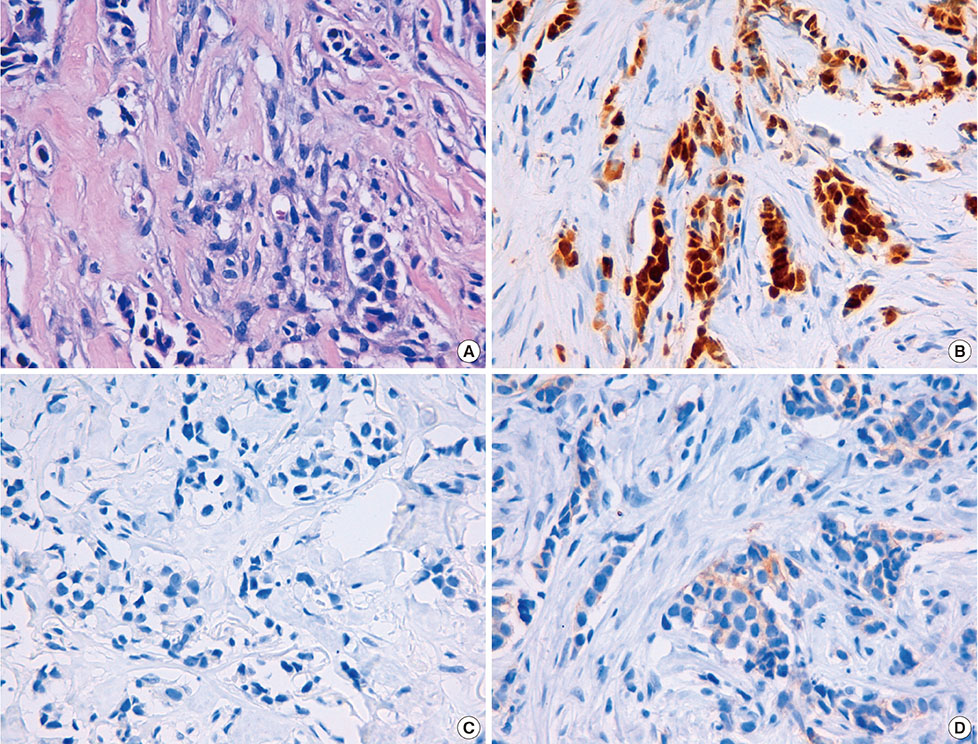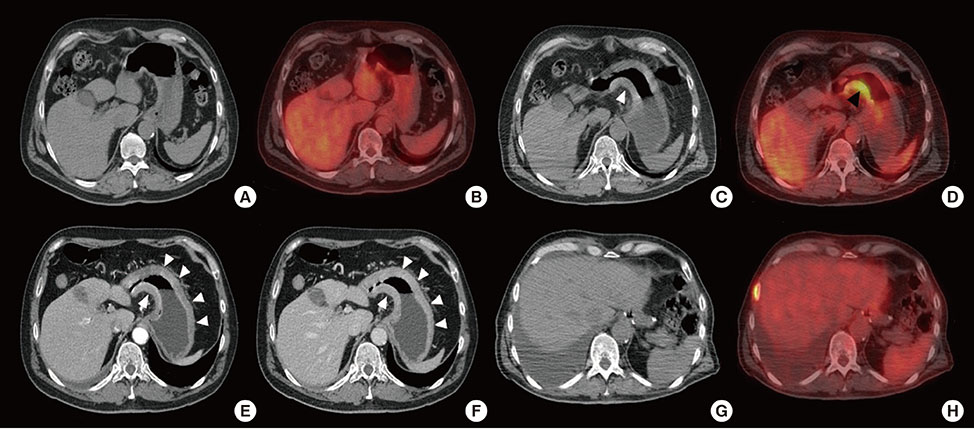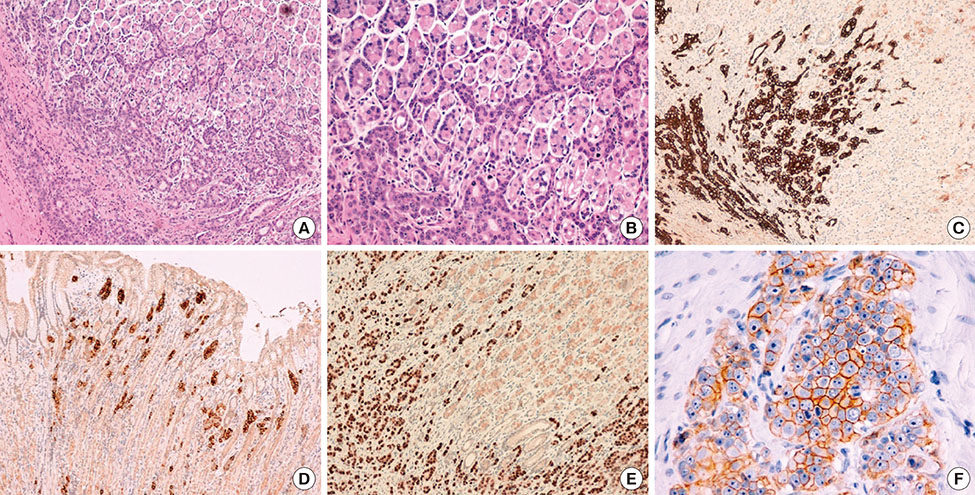J Breast Cancer.
2016 Sep;19(3):324-329. 10.4048/jbc.2016.19.3.324.
Ductal Breast Carcinoma Metastatic to the Stomach Resembling Primary Linitis Plastica in a Male Patient
- Affiliations
-
- 1Department of Medical Oncology, Santa Maria della Misericordia Hospital, Perugia, Italy. biagio.ricciuti@gmail.com
- 2Department of Experimental Medicine and Biochemical Sciences, Section of Anatomic Pathology and Histology, University of Perugia, Perugia, Italy.
- 3Department of Diagnostic Cytology and Histology Unit, Santa Maria della Misericordia Hospital, University of Perugia, Perugia, Italy.
- 4Department of Diagnostic Imaging, Santa Maria della Misericordia Hospital, University of Perugia, Perugia, Italy.
- KMID: 2413958
- DOI: http://doi.org/10.4048/jbc.2016.19.3.324
Abstract
- Breast cancer metastases to the gastrointestinal tract are very rare occurrences. Among the histological subtypes of breast cancer, invasive lobular carcinomas have a high capacity of metastasis to uncommon sites including the stomach. Conversely, there has not been sufficient evidence supporting the gastric metastasis of invasive ductal carcinoma. Herein, we report a unique case of metastatic ductal breast carcinoma mimicking primary linitis plastica in a male patient, particularly focusing on the clinical and pathological features of presentation. Moreover, we propose a immunohistochemical panel of selected antibodies including those for cytokeratin 20, cytokeratin 7, estrogen receptor, progesterone receptor, E-cadherin, gross cystic disease fluid protein 15, and GATA binding protein 3 for an accurate differential diagnosis.
Keyword
MeSH Terms
-
Antibodies
Biomarkers
Breast Neoplasms*
Breast*
Cadherins
Carcinoma, Ductal
Carcinoma, Lobular
Carrier Proteins
Diagnosis, Differential
Estrogens
Gastrointestinal Tract
Humans
Keratin-20
Keratin-7
Linitis Plastica*
Male*
Neoplasm Metastasis
Receptors, Progesterone
Stomach*
Antibodies
Biomarkers
Cadherins
Carrier Proteins
Estrogens
Keratin-20
Keratin-7
Receptors, Progesterone
Figure
Reference
-
1. Siegel R, Ma J, Zou Z, Jemal A. Cancer statistics, 2014. CA Cancer J Clin. 2014; 64:9–29.
Article2. Deb S, Lakhani SR, Ottini L, Fox SB. The cancer genetics and pathology of male breast cancer. Histopathology. 2016; 68:110–118.
Article3. Cummings MC, Simpson PT, Reid LE, Jayanthan J, Skerman J, Song S, et al. Metastatic progression of breast cancer: insights from 50 years of autopsies. J Pathol. 2014; 232:23–31.
Article4. Taal BG, den Hartog Jager FC, Steinmetz R, Peterse H. The spectrum of gastrointestinal metastases of breast carcinoma: I. stomach. Gastrointest Endosc. 1992; 38:130–135.
Article5. Ferri LE, Onerheim R, Emond C. Linitis plastica as the first indication of metastatic lobular carcinoma of the breast: case report and literature review. Can J Surg. 1999; 42:466–469.6. Ciulla A, Castronovo G, Tomasello G, Maiorana AM, Russo L, Daniele E, et al. Gastric metastases originating from occult breast lobular carcinoma: diagnostic and therapeutic problems. World J Surg Oncol. 2008; 6:78.
Article7. Madeya S, Börsch G. Gastrointestinal metastases of breast carcinoma. Gastrointest Endosc. 1993; 39:103–104.
Article8. Almubarak MM, Laé M, Cacheux W, de Cremoux P, Pierga JY, Reyal F, et al. Gastric metastasis of breast cancer: a single centre retrospective study. Dig Liver Dis. 2011; 43:823–827.
Article9. Nazareno J, Taves D, Preiksaitis HG. Metastatic breast cancer to the gastrointestinal tract: a case series and review of the literature. World J Gastroenterol. 2006; 12:6219–6224.
Article10. Yagi Y, Sasaki S, Yoshikawa A, Tsukioka Y, Fukushima W, Fujimura T, et al. Metastatic gastric carcinoma from breast cancer mimicking primary linitis plastica: a case report. Oncol Lett. 2015; 10:3483–3487.
Article11. Matsui M, Kojima O, Kawakami S, Uehara Y, Takahashi T. The prognosis of patients with gastric cancer possessing sex hormone receptors. Surg Today. 1992; 22:421–425.
Article12. van Velthuysen ML, Taal BG, van der Hoeven JJ, Peterse JL. Expression of oestrogen receptor and loss of E-cadherin are diagnostic for gastric metastasis of breast carcinoma. Histopathology. 2005; 46:153–157.
Article13. O'Connell FP, Wang HH, Odze RD. Utility of immunohistochemistry in distinguishing primary adenocarcinomas from metastatic breast carcinomas in the gastrointestinal tract. Arch Pathol Lab Med. 2005; 129:338–347.14. Davis DG, Siddiqui MT, Oprea-Ilies G, Stevens K, Osunkoya AO, Cohen C, et al. GATA-3 and FOXA1 expression is useful to differentiate breast carcinoma from other carcinomas. Hum Pathol. 2016; 47:26–31.
Article
- Full Text Links
- Actions
-
Cited
- CITED
-
- Close
- Share
- Similar articles
-
- Metastatic Gastric Linitis Plastica from Bladder Cancer Mimicking a Primary Gastric Carcinoma: a Case Report
- Primary Linitis Plastica of the Rectum: A Clinico-Pathologic Analysis of Five Cases with Special Reference to Comparison with Gastric Form
- Primary Linitis Plastica of the Colon with Mucinous Adenocarcinoma in Young Woman
- Breast Cancer Metastasis to the Stomach Resembling Early Gastric Cancer
- Synchronously Diagnosed Gastric Metastasis from Invasive Lobular Breast Carcinoma, Mimicking Primary Gastric Carcinoma




